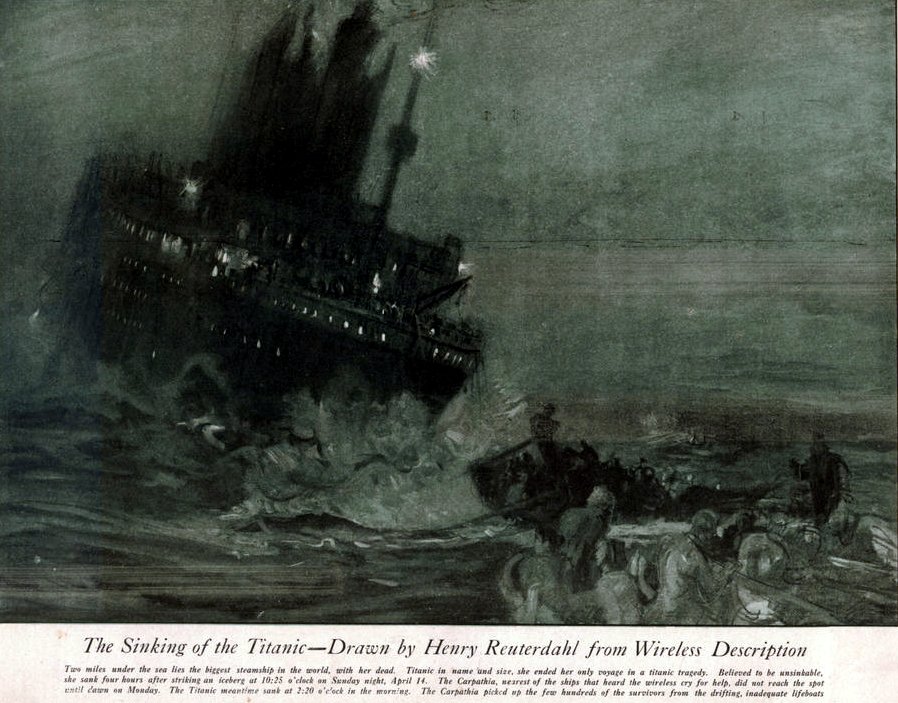Former officer says Titanic hit “growler” iceberg (1912)
From the New-York Tribune (New York, NY) April 16, 1912
Term applied by mariners to iceberg all but submerged
Speaking from his experience in ice fields both in the North and South Atlantic oceans, a former officer of an ocean liner said last night: “I fully believe that the Titanic struck what is known as a ‘growler.’
“This is a berg, the top of which, in its long drift to the southward, has been melted so that only a small portion of it — a pinnacle, perhaps — remains in sight, while below, just under the surface, spreading out like a huge turtle’s back, lies the berg itself, weighing possibly thousands of tons — a fearful menace to a ship’s bottom.
“A ‘growler’ is hard enough to distinguish from the masthead or crow’s nest in the daytime and in clear weather, but in the night in a fog or hazy weather it could not be seen, and it would tear the bottom out of any ship coming at even less than half speed.
ALSO SEE RMS Titanic facts: Our ultimate guide to the 1912 disaster & those who survived it
“All the Titanic’s bulkheads would not help her in such an emergency, for it would be like striking a solid rock, and, from what I have read of this great calamity, I believe the ship’s vitals — her engine and boiler compartments — were penetrated at the first blow.
“The wireless plant being so quickly put out of commission showed that there was trouble down there. This would also account for the pumps being unable to keep the ship afloat.”

How Titanic’s career was ended by iceberg
New-York Tribune (New York, NY) April 16, 1912
While the new ten-million-dollar White Star liner Titanic, carrying to this port some of the richest and most prominent persons in the United States and England, was steaming along on her maiden trip she crashed into a fog-hidden iceberg, to the eastward of Cape Race, at 10:25 o’clock on Sunday night, and four hours later she went to the bottom of the Atlantic.
Fresh from the builders’ yards, the biggest merchantman in the world left Southampton last Wednesday with a passenger complement of 1,470 souls and a crew of 890, and from the speed she had been making with her forced draft and picked coal, it was certain she would have reached this port in record time.
Nothing thus far has been learned to indicate her speed at the time of the collision, but from the impact with the ice mountain that sent her to the bottom it is almost certain she was plunging along at close to 21 knots, the best velocity her triple screws could give.
More than 1,500 persons believed to have perished
Only 675 souls of the 2,360 on board have thus far been accounted for, and it is believed more than 1,500 persons have perished with the biggest ship in the world, which was thought to be unsinkable.
Misfortune and mishap had camped in the wake of the Titanic’s sister ship, the Olympic, and it was hoped by the White Star Line that the latest leviathan from the Harland & Wolff yards, at Belfast, would have better luck.
Fate, however, seemed to have set its seal on the big, unwieldy queens of the Atlantic, and the Titanic did not escape. Three times had the Olympic been in trouble, the mishaps costing her owners almost a million dollars for drydocking, loss of business, and repairs.
Only once did the Titanic get in trouble. That was off Cape Race on Sunday night, when she went down in water so deep that no means known to man could bring her back to the ocean highway.
Never in the history of shipping has a vessel of her great cost and tonnage crossed the seas, much less been wiped out of existence so quickly and so unexpectedly.
She was looked upon by the shipping world as the unsinkable ship. Her builders have boasted that no seas could harm her nor could any vessel afloat damage her to the point of sinking. All these apparently substantial contentions were made with no reference to treacherous fogs or deadly icebergs, the dreaded traps of the Atlantic.

Other ships escaped same wall of ice
Probably ten or twenty feet of leeway or a half-inch turn of the steam gear wheel on the bridge would have saved the White Star beauty.
The strange part of the loss of the Titanic is that other vessels of far less tonnage encountered the same zone of ice and came in through safely. It is a rule of the sea that captains shall inform one another ahead and astern of them that ice is in the tracks. It is thought that the wireless relayed from the ship and shore must have informed Captain Smith of the dangerous ice zone ahead.
Captain Dow, of the Cunarder Carmania, which got to port on Sunday, after a five-hour fight through ice, reported that he came into the ice suddenly in a fog bank, and it is thought that the Titanic had a similar encounter, but hit the hidden iceberg before her master had time to change his course or stop her.
ALSO SEE: Inside the Titanic: When the huge ship sank in 1912, here’s what the luxurious interior looked like
While it is generally understood that all vessels shall reduce their speed to half when running through fog, this rule is not always put into force by the captains of steamships of great tonnage. Some of them run at high speed, on the theory that whatever they hit head-on must suffer the damage, while their own chances of getting off light are in the majority.
J Bruce Ismay, president of the International Mercantile Marine Company, whose father left him the biggest bulk of the stock of the White Star Line, was one of the Titanic’s passengers. He was anxious to see how the big vessel behaved on the westward run, and incidentally, make personal observations for the improvement of the service on board.

Fairly good weather preceded accident
The lost liner had had fairly good weather up to the time of her encounter with the fog. The entire voyage had been one of merriment, and in varous lounges, even at the time her sharp stem ploughed into the immovable ice wall, men and women in evening dress sat about sipping coffee and playing cards.
Judging from the terrific jolt the ice gave the Anchor liner Columbia a year ago, running at about eight knots, the Titanic’s passengers must have been thrown violently about and many injured. No one aboard knew better than the venerable Captain Smith, commodore of the fleet, that the Titanic’s death knell had been sounded.
He knew when the high sharp stem pierced the almost adamantine berg with all the force of the highest-powered engines in the world behind it that there was no hope for his steel charge.
Many of those who had retired were thrown out of their berths, and ran half-clad to the decks, while those who had been lolling in the libraries, smoking rooms, and lounges ran for safety.
The snapping of steel plates and the creaking of wooden fittings in such a crisis as this is enough to frighten the most courageous traveler. As the Titanic’s bow buckled in its niche of green ice with a roar that reverberated no doubt in the frosted graveyard in which she was soon to lie, tons of the softer ice crashed upon the splintered deck forward and forced her to drink long and deep of the waters that were soon to pull her under.
ALSO SEE: How I was saved from the Titanic: A Titanic survivor’s story (1912)




















One Response
This is fascinating! It’s interesting to see what folks in 1912 knew about the tragedy, compared to today.
Where was the this report first published?
Here’s a Titanic App that has taken off among history buffs, which you might enjoy: http://www.historypressblog.net/2012/03/15/new-titanic-app-for-history-buffs/
Another great resource is the @TitanicRealTime twitter account, which is dedicated to creating historically based tweets from the perspectives of crew, captain and key passengers, as if from 100 years ago.